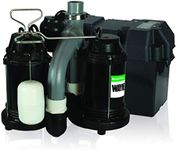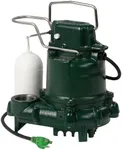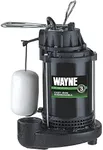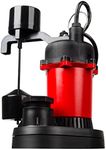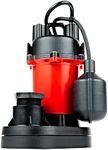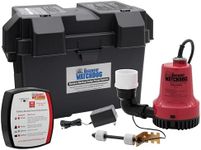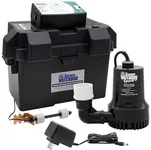Buying Guide for the Best Sump Pumps
Choosing the right sump pump is important for keeping your basement or crawl space dry and protecting your home from water damage. The best sump pump for you depends on the size of the area you need to protect, how much water you expect to deal with, and how often you experience heavy rain or flooding. Understanding the key features and specifications will help you make a confident decision that matches your needs.Pump Type (Submersible vs. Pedestal)Sump pumps come in two main types: submersible and pedestal. Submersible pumps sit inside the sump pit and are designed to be underwater, making them quieter and more discreet. Pedestal pumps have the motor above the pit, making them easier to service and often longer-lasting, but they can be noisier. If you have a small or narrow pit, a pedestal pump might fit better, while a submersible pump is ideal for larger pits or if you want quieter operation.
Horsepower (HP)Horsepower measures the strength of the pump's motor and affects how much water it can move. Common values are 1/4 HP, 1/3 HP, 1/2 HP, and 3/4 HP. Lower horsepower pumps (1/4 or 1/3 HP) are suitable for smaller homes or areas with minimal water issues. Higher horsepower (1/2 HP or more) is better for larger basements, areas with frequent flooding, or if you need to move water quickly. Choose based on the size of your space and how much water you expect to handle.
Flow Rate (Gallons Per Hour or GPH)Flow rate tells you how much water the pump can move in an hour, usually measured in gallons per hour (GPH) at a certain height (called 'head'). Higher GPH means the pump can remove water faster. For light water problems, a lower GPH is fine, but for heavy flooding or large basements, look for a higher GPH. Consider the typical water volume you need to remove and match the pump's flow rate to that need.
Head Height (Lift Capacity)Head height, or lift capacity, is the maximum vertical distance the pump can move water from the pit to the discharge point. If your discharge pipe runs a long way up or out of your basement, you'll need a pump with a higher head height. Measure the distance from your sump pit to where the water exits your home and make sure the pump can handle at least that much lift.
Switch Type (Float, Diaphragm, Electronic)The switch turns the pump on and off automatically when water reaches a certain level. Float switches are common and reliable, rising with the water to activate the pump. Diaphragm switches sense pressure changes, while electronic switches use sensors. Float switches are simple and work well for most people, but if you have a narrow pit, a vertical float or electronic switch might be better. Choose a switch type that fits your pit size and reliability needs.
Material and Build QualitySump pumps are made from materials like plastic, cast iron, or stainless steel. Cast iron and stainless steel are more durable and handle heavy use better, while plastic pumps are lighter and less expensive but may not last as long. If you expect frequent use or want a long-lasting pump, choose one with a sturdy metal construction. For occasional use, a plastic pump may be sufficient.
Backup System CompatibilityPower outages often happen during storms, so having a backup system (like a battery backup or water-powered backup) is important if you want extra protection. Some pumps are designed to work with backup systems or even include them. If your area is prone to power outages or you want peace of mind, look for a pump that can be paired with a backup system.
